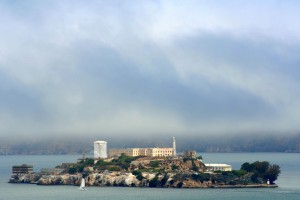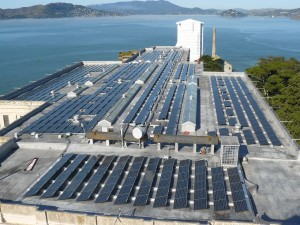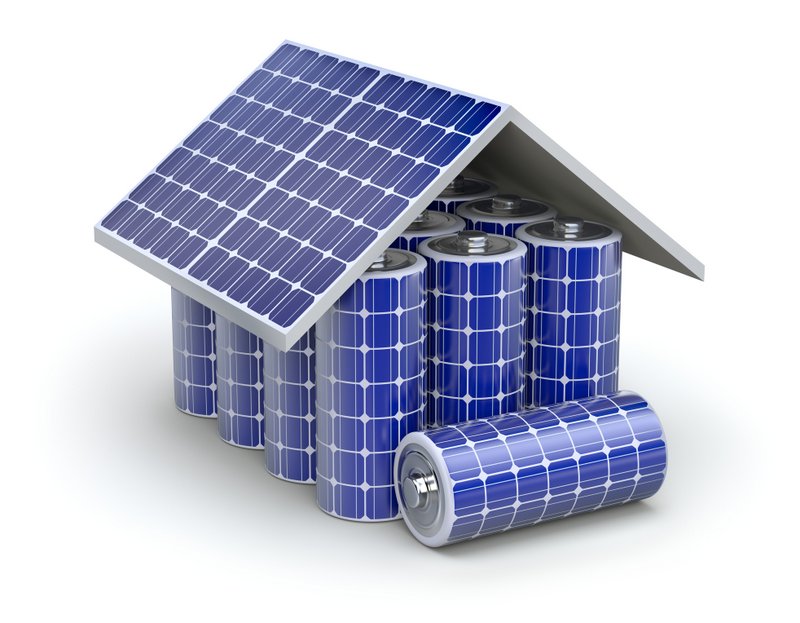Escape from (Fossil Fuels at) Alcatraz
The national historic landmark recently installed solar power in a way that doesn’t change the island’s authenticity but does shrink its carbon footprint.
It’s safe to say that Al Capone never saw a solar panel. The solar cell was first patented in 1946, more than a decade after Capone was indicted for income tax evasion. During his nearly seven-year imprisonment, he spent five of those years at Alcatraz, a federal prison at the time. Eighty years later, Alcatraz Island is a popular tourist destination known for its historical integrity.
 So the National Park Service (NPS) doesn’t want tourists to Alcatraz to see solar panels either — just as Capone didn’t. It would ruin the historical experience. When people visit historical sites, they want to experience them as they were seen during a significant point in history — not as a modernized version of the past.
So the National Park Service (NPS) doesn’t want tourists to Alcatraz to see solar panels either — just as Capone didn’t. It would ruin the historical experience. When people visit historical sites, they want to experience them as they were seen during a significant point in history — not as a modernized version of the past.
That’s why, even though Alcatraz is now home to a 307-kW solar power system, visitors probably won’t notice. But the NPS will notice — 60 percent of its annual electricity needs at Alcatraz will be generated by the system and nearly 700,000 lbs of carbon dioxide emissions will be eliminated each year.
“For the National Park Service, one of our overall missions is to protect and preserve for future generations,” says Alexandra Picavet, spokesperson for the Golden Gate National Recreation Area (GGNRA), a rec area administered by the NPS that surrounds the San Francisco Bay area. “One of the large-scale ways that the National Park Service is trying to do that is to lower its carbon footprint on the areas that we exist. Alcatraz is one of the largest carbon footprints that the Golden Gate National Recreation Area has and the National Park Service has on the West Coast.”
Alcatraz Island is completely cut off from the mainland. No electrical or water lines connect the 22-acre land mass to San Francisco. Diesel fuel for electric generators is ferried to the island (previously up to 2,000 gal each week), and garbage and sewage is carried back. These inefficiencies led the NPS and GGNRA to turn to renewable energy for help providing electricity to Alcatraz and its 1.4 million visitors each year.
“Solar was the best options for a lot of reasons. It could be tucked into the historic structures in such a way that it didn’t become a dominate feature of the island like wind [power] would,” Picavet says. “We worked with the State Historic Preservation Office (SHPO) — who helps manage all historic landmarks in California to be sure that they’re not being altered in a major way — to find the best solution, and that was to put a very large solar array on the roof of the cell house, which is the highest point on the island except for the lighthouse.”
Bay neighbors SunLink Corp. were called in to work on special mounting systems for the unique project. Ignoring the challenge of keeping the panels out of sight of visitors, an even larger obstacle to tackle was San Francisco Bay’s demanding environment. SunLink CEO Chris Tilley says the area is windy and salty, and solar power installations don’t really like those things.
“[Alcatraz] sits in the middle of San Francisco Bay. It’s what’s called an exposure D category for wind, which is considered to be the most difficult wind exposure category you could have,” Tilley says. “It also sits on top of a rock that comes up, and that tends to speed up the wind as well. And the salt water [provides for a] corrosive environment. SunLink is known for our engineering expertise, particularly related to wind and doing mounting structures that are difficult to do. This was certainly the case in this project.”
 The mounting system is made of aluminum and stainless steel, which works well in corrosive environments. SunLink also provided custom components, including system feet designed to absorb extreme wind impacts, to resist the elements. The system at Alcatraz is a penetrating rooftop system, but extra care was taken with attaching it to the main cell house.
The mounting system is made of aluminum and stainless steel, which works well in corrosive environments. SunLink also provided custom components, including system feet designed to absorb extreme wind impacts, to resist the elements. The system at Alcatraz is a penetrating rooftop system, but extra care was taken with attaching it to the main cell house.
“It’s very, very old,” Tilley says of the building. “There was a lot of care in the structural engineering and how connections were put in. You would have exactly the same challenges with ballast, but this was a more effective means to achieve the goals.”
The panels were set at two different tilt angles — 5 degrees and 15 degrees.
“Ideally, you would get more production out of a 15-degree system but it rises higher off the roof so it can be visible,” Tilley says. Two sections were set at different levels, pulling the most sunlight without being flashy to tourists.
The 307-kW system — attached to two battery packs, which helps store energy to reduce the running time of the generators from 100 percent down to 40 percent — was completed in the summer of 2012 after years of planning. The $3.6 million project was funded by the American Reinvestment and Recovery Act and will provide significant savings. Even in the 1960s, it was determined that Alcatraz was a money pit. Attorney General Robert F. Kennedy closed the federal penitentiary in 1963 after finding it was the most expensive prison in the nation — costing $10 per prisoner per day as opposed to $3 per day in Atlanta. The site was added to the National Register of Historic Places in 1976 and became a designated National Historic Landmark in 1986.
“If you go on the tour [of the island], they’re showing what it was like to be a prisoner there,” Tilley says. “There is a whole atmosphere angle to this — you come onto the island and you’re stepping back in time. You’re seeing what Al Capone and others did. The idea of showing some modern solar installation conflicts with what that intention is. When you go to an historic site, you’re trying to imagine what it was historically.”
 Picavet says the NPS is pleased with the solar installation at Alcatraz, and the organization is not shying away from expressing its new take on energy consumption. Some tours of the island now include information on the solar power system and the island’s sustainability efforts.
Picavet says the NPS is pleased with the solar installation at Alcatraz, and the organization is not shying away from expressing its new take on energy consumption. Some tours of the island now include information on the solar power system and the island’s sustainability efforts.
“We’re really excited to have this as a really large change in the way we do business on Alcatraz,” she says. “It’s a large cost savings for us. The gas and the diesel to run the generators all the time has been greatly reduced, and so has the wear and tear on the generators.”
Things might be running a little differently behind the scenes at Alcatraz than they did when Al Capone roamed the halls in the 1930s, but as far as visitors can tell, it’s all exactly the same.





Comments are closed here.